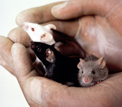DTP Branches and Offices
Milestone (1998)

Three strains of mice. Courtesy of NCI. 1983.
Mouse Models of Human Cancers Consortium (MMHCC)
“The Consortium is an extraordinary opportunity that should greatly improve our ability to understand the process of cancerous changes. We are also trying to enhance our ability to evaluate a range of biomarkers prior to their clinical use…The Consortium will provide easy ways for the groups to share their observations and accomplishments, and explore possible solutions to any technological challenges that presently limit mouse models as effective mimics of human disease.”
Until recently, the only factors available to measure anticancer activity in any model were inhibition of cell or tumor growth and the increased lifespan of the animal. Cancer-specific molecular targets were unknown, and investigators did not have the tools to measure the therapeutic effects or targets in biologic fluid or tissue. In addition, existing models did not predict well for clinical outcome. DTP is working with the Mouse Models of Human Cancers Consortium (MMHCC) to design studies examining the predictive value of genetically engineered mouse (GEM) models.
The MMHCC was established in 1998 as a collaborative program to derive and characterize mouse models, to generate resources and information, and to use innovative approaches in preclinical and drug intervention studies.1 The MMHCC comprises 25 principal investigators whose research groups connect more than 50 institutions in the United States and abroad. More than 80 mouse strains are now available to cancer researchers.3
The MMHCC also maintains the eMICE Website,1,4 which provides:
- Information on mouse models by disease site,
- Information on the applications of mouse cancer models to translational research,
- Links to other mouse-related resources, strain repositories, and databases,
- Access to the MMHCC Mouse Repository Website, Cancer Models Database, and Cancer Images Database, and
- Access to the caArray Database.
Mouse models that recapitulate steps in the genesis, progression, and clinical course of human cancers provide a valuable resource to cancer researchers, particularly in the field of drug discovery and development. The availability of these models via the MMHCC repository, which makes animal strains available to all members of the scientific community, is a key to discoveries that will lead to new approaches for cancer detection, diagnosis, therapy, and prevention.2
1 Mouse Models of Human Cancers Consortium (MMHCC) Website.
2 National Cancer Institute. NCI Establishes a Mouse Cancer Models Repository and Distribution Facility.
3 Mouse Models of Human Cancers Consortium. Mouse Strains Being Distributed.
4 National Cancer Institute. NCI Establishes a Mouse Cancer Models Repository and Distribution Facility.
5 National Cancer Institute. NCI Establishes Consortium to Develop Mouse Models of Human Cancers.
Link:





